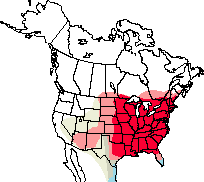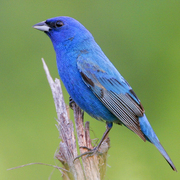Indigo Bunting
Passerina
cyanea
Passeriformes
Members of this diverse group make up more than half of the bird species worldwide. Most are small. However their brains are relatively large and their learning abilities are greater than those of most other birds. Passerine birds are divided into two suborders, the suboscines and the oscines. Oscines are capable of more complex song, and are considered the true songbirds. In Washington, the tyrant flycatchers are the only suboscines; the remaining 27 families are oscines.
Cardinalidae
This group, the cardinalids, is made up of medium-sized songbirds that primarily inhabit open areas and woodland edges. The family is tropical in origin and restricted to the Americas. Northern-breeding members generally have strong sexual dimorphism: adult males are brightly colored, while females are drab. They are seedeaters and have powerful, conical bills that can crack seeds. These birds also eat fruit and insects. Most of those that breed in the northern temperate zone are migratory and monogamous. The common names of several species in the Cardinalidae family can be confusing, because some birds that are called buntings or grosbeaks belong to different families. Snow Bunting, McKay’s Bunting, and Rustic Bunting are actually members of the Emberizidae, and Evening Grosbeak belongs to the Fringillidae.
General Description
Casual in spring and summer, accidental in fall.
North American Range Map









